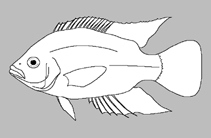Haplochromis planus Vranken, Van Steenberge & Snoeks, 2020
Uploaden van uw Foto's en video's
Google afbeeldingNo image available for this species;
drawing shows typical species in Cichlidae.
Google afbeeldingNo image available for this species;
drawing shows typical species in Cichlidae.
Classificatie / Names Lokale namen | Synoniemen | Catalog of Fishes(Genus, Soort(en)) | ITIS | CoL | WoRMS | Cloffa
> Cichliformes (Cichlids, convict blennies) > Cichlidae (Cichlids) > Pseudocrenilabrinae
Etymology: Haplochromis: Greek, Haploos = single + Greek, chromis = a fish, perhaps a perch (Ref. 45335); planus: Specific name from Latin planus, flat, referring to its flat, shovel-like lower jaw (Ref. 126074).
Etymology: Haplochromis: Greek, Haploos = single + Greek, chromis = a fish, perhaps a perch (Ref. 45335); planus: Specific name from Latin planus, flat, referring to its flat, shovel-like lower jaw (Ref. 126074).
Environment: milieu / climate zone / depth range / distribution range Ecologie
; zoet water pelagisch. Tropical
Verspreiding Landen | FAO regio's | Ecosystemen | Voorkomen | Point map | Introducties | Faunafri
Africa: endemic to Lake Edward (Ref. 126074).
Grootte / Gewicht / Leeftijd
Korte beschrijving Determinatiesleutels | Morfologie | Morfometrie
Dorsale stekels (totaal) : 14 - 16; Dorsale zachte stralen (totaal) : 9 - 10; Anale stekels: 3; Anale zachte stralen: 8 - 9; Wervels: 20 - 21. Diagnosis: Haplochromis planus differs from all other species of Haplochromis, except H. retrodens from Lake Victoria, by a shallow, broad and rectangular lower jaw with ascending arms steeply sloping upwards, enlarged and distinctly visible intrabuccally; oral-tooth bands U-shaped and, in large specimens of more than 75 mm standard length, set posteriorly with large and stout inner and outer teeth, especially in upper jaw; all oral mucosa in lower jaw at same height and oral-breathing valves strongly reduced to narrow, rectangular skin folds (Ref. 126074). It differs from H. retrodens by larger eyes, 35.7-41.6% of head length vs. 23.8-29.6%, correlated shorter snout, 24.6-28.8% of head length vs. 29.0-36.8%, and more slender interorbital width, 19.1-22.1% of head length vs. 24.2-33.8%, and dominant males with scarlet to red vs. dark grey-green flanks (Ref. 126074). It differs from H. concillans and H. erutus by a shallow vs. deep lower jaw, a narrower interorbital region, 19.1-22.1% of head length vs. 22.5-26.4% and 23.4-27.2% respectively, and dominant males with scarlet to red vs. blue-silver and silver-beige flanks, respectively; it differs further from H. concillans by a longer premaxillary pedicel, 21.9-24.4% of head length vs. 16.1-21.6%, and from H. erutus by a longer upper jaw, 27.6-32.1% of head length vs. 20.9-26.0% (Ref. 126074).
Levenscyclus en paargedrag Maturiteit | Voortplanting | Paaien | Eieren | Fecunditeit | Larven
Hoofdreferentie
Upload your references | Referenties | Coördinator : Kullander, Sven O. | Medewerkers
Vranken, N., M. Van Steenberge and J. Snoeks, 2020. Similar ecology, different morphology: three new species of oral-mollusc shellers from Lake Edward. J. Fish Biol. 96(5):1202-1217. (Ref. 126074)
CITES
Not Evaluated
Gevaar voor de mens
Harmless
Gebruik door de mens
FAO - Publication: search | FishSource |
Meer informatie
Population dynamics
Groeiparameters
Max. ages / sizes
Length-weight rel.
Length-length rel.
Lengtefrequenties
Massaconversie
Rekrutering
Abundantie
Groeiparameters
Max. ages / sizes
Length-weight rel.
Length-length rel.
Lengtefrequenties
Massaconversie
Rekrutering
Abundantie
Life cycle
Voortplanting
Maturiteit
Maturity/Gills rel.
Fecunditeit
Paaien
Spawning aggregations
Eieren
Ontwikkeling van de eieren
Larven
Larvale populatiedynamiek
Voortplanting
Maturiteit
Maturity/Gills rel.
Fecunditeit
Paaien
Spawning aggregations
Eieren
Ontwikkeling van de eieren
Larven
Larvale populatiedynamiek
Anatomy
Kieuwoppervlak
Brain
Otolith
Kieuwoppervlak
Brain
Otolith
Physiology
Body composition
Nutrients
Zuurstofverbruik
Zwemtype
Zwemsnelheid
Visual pigments
Fish sound
Diseases & Parasites
Toxicity (LC50s)
Body composition
Nutrients
Zuurstofverbruik
Zwemtype
Zwemsnelheid
Visual pigments
Fish sound
Diseases & Parasites
Toxicity (LC50s)
Genetics
Genetica
Heterozygosity
Erfelijkheid
Genetica
Heterozygosity
Erfelijkheid
Human related
Aquaculture systems
Aquacultuurprofielen
Kweeklijnen
Ciguatera cases
Stamps, coins, misc.
Aquaculture systems
Aquacultuurprofielen
Kweeklijnen
Ciguatera cases
Stamps, coins, misc.
Tools
E-boek | Veldgids | Lengtefrequentie Tool | Levenscyclus tool | Verspreidingskaart | Classification Tree
| Catch-MSY |
Speciale rapporten
Bekijk gegevens voor het houden in een aquarium | Bekijk Fact Sheets voor de soort | Bekijk Aquacultuur Fact Sheets
Download XML
Internetbronnen
AFORO (otoliths) | Aquatic Commons | BHL | Cloffa | BOLDSystems | Websites from users | Bekijk FishWatcher | CISTI | Catalog of Fishes: Genus, Soort(en) | DiscoverLife | ECOTOX | FAO - Publication: search | Faunafri | Fishipedia | Fishtrace | GenBank: genoom, nucleotide | GloBI | Google Books | Google Scholar | Google | IGFA World Record | MitoFish | Otolith Atlas of Taiwan Fishes | PubMed | Reef Life Survey | Socotra Atlas | Tree of Life | Wikipedia: ga naar, zoek | World Records Freshwater Fishing | Zoobank | Zoological Record
Estimates based on models
Fylogenetische diversiteitsindex (Ref. 82804): PD50 = No PD50 data [Uniqueness, from 0.5 = low to 2.0 = high].
Bayesian length-weight: a=0.01445 (0.00674 - 0.03099), b=2.99 (2.82 - 3.16), in cm total length, based on LWR estimates for this (Sub)family-body shape (Ref. 93245).
Trofisch niveau (Ref. 69278): 3.3 ±0.4 se; based on size and trophs of closest relatives
Weerstandsvermogen (Ref. 120179): Hoog, minimale populatieverdubbelingstijd minder dan 15 maanden (Preliminary K or Fecundity.).
Fishing Vulnerability (Ref. 59153): Low vulnerability (10 of 100).




